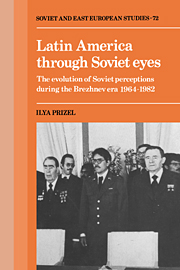 Latin America through Soviet Eyes
Latin America through Soviet Eyes Book contents
- Frontmatter
- Contents
- Preface
- Acknowledgments
- Introduction
- Part I Soviet perceptions of Latin America's global role
- Part II Soviet perceptions of Latin American social structures
- Introduction
- 6 The Latin American church
- 7 The Latin American armed forces
- 8 Latin American labor unions
- 9 Bourgeois political parties
- 10 Wars of national liberation or peaceful transformation?
- Part III Soviet–Latin American relations during the Brezhnev era
- Part IV Conclusion: the emerging Soviet perception of Latin America and the future of Soviet policy toward the hemisphere
- Conclusions
- Epilogue – Latin America: the Long March
- Notes
- Bibliography
- Index
8 - Latin American labor unions
Published online by Cambridge University Press: 05 February 2012
- Frontmatter
- Contents
- Preface
- Acknowledgments
- Introduction
- Part I Soviet perceptions of Latin America's global role
- Part II Soviet perceptions of Latin American social structures
- Introduction
- 6 The Latin American church
- 7 The Latin American armed forces
- 8 Latin American labor unions
- 9 Bourgeois political parties
- 10 Wars of national liberation or peaceful transformation?
- Part III Soviet–Latin American relations during the Brezhnev era
- Part IV Conclusion: the emerging Soviet perception of Latin America and the future of Soviet policy toward the hemisphere
- Conclusions
- Epilogue – Latin America: the Long March
- Notes
- Bibliography
- Index
Summary
The proletarianization of Latin America began almost at the instant Columbus landed on the continent. The development of a vast mining industry in Spanish America, and later the introduction of an export oriented plantation economy, created a substantial proletariat in the Americas well before the emergence of similar phenomena in much of Asia and Africa, and even parts of Europe. Increased European immigration during the latter half of the nineteenth century and early twentieth century, along with the economic impetus given the hemisphere by World War I, helped create an enlarged proletariat in parts of Latin America by the time the Bolsheviks seized power in Russia in 1917.
The presence of large proletarian populations in Latin America facilitated the establishment, by Comintern operatives, of communist parties in Argentina, Chile, Mexico, Uruguay, and other countries within a few years of Russia's October revolution. At the same time as the Comintern was expanding its operations in the hemisphere in the early 1920s, a Latin American labor union movement was emerging. By 1925 various communist parties had managed to make inroads in this movement, and until well after World War II the communist-dominated unions would play a significant (although not always successful) role in the hemisphere's political struggles. In fact, Latin America proved to be a testing ground for strategies that would be attempted in Europe – domination of labor unions by relatively small and insignificant communist parties and Soviet use of communist-dominated unions as a policy instrument (for example, in France, Germany, and Italy).
- Type
- Chapter
- Information
- Latin America through Soviet EyesThe Evolution of Soviet Perceptions during the Brezhnev Era 1964–1982, pp. 110 - 118Publisher: Cambridge University PressPrint publication year: 1990
